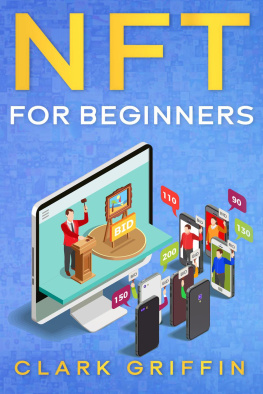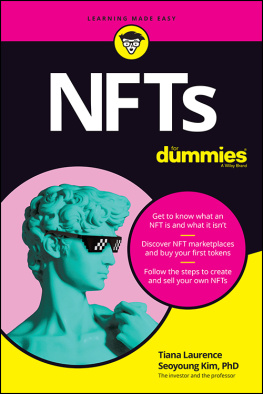THE
NFT REVOLUTION
REAL ESTATE EDITION
2 IN 1 PRACTICAL GUIDE FOR BEGINNERS
TO CREATE, BUY AND SELL NON-FUNGIBLE TOKENS & DISRUPTIVE PROJECTS OF VIRTUAL LAND, PROPERTIES AND WORLDS
CRYPTO DUKEDOM
All rights reserved. No part of this book may be reproduced or stored in a retrieval system or transmitted in any form or by any means, electronic or mechanical, including photocopying, recording, or by any informational storage system without express written permission of the publisher.
First edition: April 2021.
Published by CRYPTO DUKEDOM
INTRODUCTION
" The technology is real. The impact is real and permanent." That's a statement from billionaire investor and NBA franchise owner Mark Cuban, who is at the forefront of the explosion of interest in blockchain and non-fungible token technology. According to Cuban, the impact of this monetary technological shift is measurable and lasting. Once stabilized, it will disrupt how money is invested, collected, played with, and made.
Whether it's sports, entertainment, gaming, art, music, or fashion, non-fungible tokens are a perfect fit for any industry or field. This revolutionary technology has been talked about increasingly in the past few months, but not everyone knows about it yet, and its potential has not yet been fully imagined.
Non-fungible tokens, more simply called NFTs, are a unique digital resource. Indeed, what the non-fungible token creates is a verifiable digital scarcity, which results in unique value.
Those who already understand a bit about blockchain, cryptocurrencies, and tokens know what we are talking about and will be able to untangle this type of technology better. In simple words, you could say that a fungible token consists of digital information recorded in a blockchain that grants the object a particular right that is recognizable as ownership. Tokens are, in essence, a certificate of authenticity, while fungible refers to the replicability and interchangeability of cryptocurrencies such as Bitcoin, the cryptocurrency created in 2009, or even a fiat currency (dollar, euro, pound, etc.). Non-fungible tokens are distinguishable precisely by their non-fungibilitythat is, their non-interchangeability. They are able to provide a unique representation of a virtual asset and are authentic, unique, and encrypted.
An image in a .jpg file, for example, can be replicated countless times, but the token cannot be, and it is the token itself that gives value to the image, enabling it to bought, sold, and collected like the finest works of art. Therefore, the purchased token is a certification of the media or digital work, not the work itself. NFTs, consequently, give a digital creation all the rights it would have as a physical work: rarity, authenticity, and ownership. That's what makes an NFT so extraordinary. Non-fungible tokens are changing the digital world forever. It's a bit like an artist creating a work of art for just one person: many might admire it on the web and appreciate its beauty, but only the person who buys it holds the rights of ownership, including the ability to resell it and make a profit.
Talking about NFT is a bit like referring to a parallel universe that is growing exponentially. Indeed, recent depictions of NFT use words like mania and bubble to describe the situation.
In 2020, the trading volume of the NFT market exceeded $250 million, a four-fold increase over 2019, and they are continuing to grow by the minute even at the time of this writing. It's a world that has quickly garnered the attention of celebrities, international artists, sports figures, digital creatives, entrepreneurs, influencers, and many more.
Several striking cases have made their way around the web. For instance, it's hard not to have heard of how the NBAs NFT platform, NBA Top Shot, sold a clip of Lebron James formidable dunk for$ 208k or how Lindsay Lohan sold a photo of herself for +$50k dollars and donated the proceeds to charity. The same celebrities who have taken an interest in non-fungible tokens have brought them into the limelight by making them mainstream and grossing record amounts. Besides, NFTs can be found in virtually every industry, from business and social media to music, art, sports, and entertainment.
The exclusivity of digital files has resulted in them selling for millions of dollars. Following the granular price tiering principle, an artist sells their most exclusive works at higher prices and subsequent works at lower prices. Moreover, NFTs are so great precisely because of their ability to remove all intermediation: artist and buyer are in direct contact in a whole new way.
Grimes, famous synth-pop star, singer, and girlfriend of well-known entrepreneur Elon Musk, earned $5.8 million in less than 20 minutes by selling her NFTs on Nifty Gateway, one of the most popular marketplaces. The collection was titled War Nymph. It features winged children sporting javelins, tattoos, and elf ears in a dystopian world. The singer first announced the auction of her NFTs in a tweet, writing simply: Enter the void. With respect to this digital world, she declared: "The digital realm makes the realm more rare and precious. It also offers escapism and perfection. Sometimes I want imperfection, real life. Sometimes I want perfection."
Like her and also in the music business, Kings of Leon recently got into the craze. They released their album When You See Yourself as an NFT on the Yellowheart platform. The album is available to everyone in traditional formats, but those in NFT were sold for $50, each offering different perks: digital downloads, concert tickets, and a limited-edition vinyl copy of the album. In this way, digital becomes physical and vice versa, creating a unique and original offering.
Just over a year ago, Twitter founder and CEO Jack Dorsey also auctioned off the NFT of his first tweet from 2006 in which he declared "Just setting up my twitter." It sold for $2.9 million, and he donated the proceeds to charity. The platform on which he sold his NFT is Valuables by Cent. If even the tech enthusiast and founder of a platform as popular as Twitter has entered the world of NFT auctions, we can assume theres some potential there.
The most glaring case in point? Beeple, a digital graphic designer originally from South Carolina, kick-started a real crypto art movement by selling his work titled The First 5000 days for $69.3 million, the highest quote ever achieved by a digital artist. The famous art auction house Christie's is relying on MakersPlace to support the new digital trend, seeing great opportunities for a world of art in which even the younger generations, accustomed to digital creations, can invest.
How does an intangible good that everyone can see reach such a value? How and who can create and sell their works in NFT? What applications and results can they generate in the future? Is this a stable market in which to invest?
In this guide, we will answer these and other similar questions as we provide a detailed introduction to and analysis of non-fungible tokens: what they are, how they are created, what is their market, what are there possible uses, opportunities, merits, and demerits, and more, including famous collections and artists as well as case studies of a phenomenon that is as revolutionary as it is recent.
The possibilities of selling, collecting, investing, and earning are what make non-fungible tokens a compelling technological opportunity. Moreover, this opportunity will not be extinguished, as it is likely to find more and more markets and uses. So, without further ado, let's begin our clear, simple, thorough, and beginner-proof analysis of NFTs.
BRIEF HISTORY
A lthough the success of NFTs has exploded relatively recently (thanks largely to the record $69.3 million sale of the digital artwork by artist Beeple, stage name Mike Winkelmann, which was hammered out by Christie's auction house at 4 p.m. on March 11, 2021), NFT is not a new technology. Following the emergence of Bitcoins, projects have sprung up that take advantage of the particular internal protocol of the Bitcoin blockchain. By closely monitoring the origin of a given bitcoin, a set of coins can be colored to distinguish it from the rest. These coins can then have special properties and a value independent of the bitcoins' face value. The use of these protocols has generated tokens that have been called "colored coins." These colored coins, born around 2012-2013, were actually the first NFTs in history.








